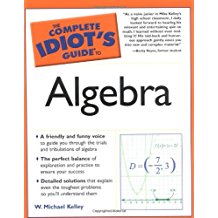Algebra: Special Factoring Patterns
Special Factoring Patterns
Sometimes, you hardly have to do any work at all to factor a polynomial. This appeals to me, because deep down, I am a very lazy man, and if I didn't have to feed myself or my family, I'd be happily working a meaningless job and living in squalor (as I proved beyond any reasonable doubt when I was a bachelor). In some circumstances, all you have to do is recognize that the polynomial at hand follows a certain pattern. To spot these handy, time-saving patterns, you'll need to be able to spot perfect squares and perfect cubes.
A perfect square is what you get when you multiply something by itself (in other words, the result of squaring something). For instance, 36w4 is a perfect square, since it's the result of something multiplied by itself: (6w2)(6w2) = 36w4.
A perfect cube can be created by multiplying something by itself two times (in other words, the result of cubing something). Therefore, -8y3 is a perfect cube, since (-2y)(-2y)(-2y) = -8y3.
Here are the special factor patterns you should be able to recognize. Memorize the formulas, because in some cases, it's very hard to generate them without wasting a lot of time.
Talk the Talk
A perfect square is a quantity that results when something is multiplied by itself, and a perfect cube is the result of multiplying something by itself twice.
Kelley's Cautions
Note that you cannot factor the sum of perfect squares as easily as the difference. In fact, as far as you're concerned, you cannot factor a2 + b2, even though most algebra students try to factor it as (a + b)(a + b), which is totally wrong! If you multiply (a + b)(a + b), you get a2 + 2ab + b2, not a2 + b2. (If you need to review polynomial multiplication, it's covered in Introducing Polynomials.)
- The difference of perfect squares: If two squares are subtracted, (a2 - b2), you can automatically rewrite the difference as a binomial product (a + b)(a - b). For example, the polynomial x2 - 16 is a difference of perfect squares, since x2 - 16 = (x)2 - (4)2. (If you compare x2 - 16 to the formula a2- b2, a = x and b = 4, as they are the numbers that generate the perfect squares.) Therefore, it can be factored as (x + 4)(x - 4).
- The difference of perfect cubes: If two perfect cubes are subtracted, they can be factored as the product of a binomial and a trinomial: (a3 - b3) = (a - b)(a2 + ab + b2). For example, given the polynomial 8x3 - 27 (in this case, a = 2x and b = 3), its factored form is (2x - 3)((2x)2 + (2x)(3) + (3)2), or (2x - 3)(4x2 + 6x + 9).
- The sum of perfect cubes: Unlike the sum of perfect squares, when perfect cubes are added together, they do follow a specific factor pattern. This pattern differs only slightly from its sister formula, the difference of perfect cubes; in fact, only a few signs are different: (a3 + b3) = (a + b)(a2 - ab + b2). Consider the polynomial y3 = 64; this represents the sum of perfect cubes a3 + b3 when a = y and b = 4, so according to the formula, its factored form is (y + 4)(y2 - 4y + 16).
One word of caution: Factoring by means of these special patterns works hand in hand with, not in opposition to, factoring using the greatest common factor. In fact, you should always look for a greatest common factor (and if it exists, factor it out) before trying to apply any other factoring technique. This guarantees that you'll get the fully factored form of the polynomial, and in some cases, will change the problem from impossible to easy.
Example 3: Factor the polynomials.
Kelley's Cautions
Always assume that you're expected to factor a polynomial completely. In other words, none of the resulting factors should, in turn, be factorable.
You've Got Problems
Problem 3: Factor the polynomial 5x2 - 125.
- (a) 16x3 + 2y3
- Solution: This feels like a sum of perfect cubes problem, thanks to the powers of 3, but it doesn't exactly fit the formula. Even though x3 is a perfect cube, 16x3 isn't. (There's no rational number that multiplied by itself twice gives you 16.) Same goes for the other term.
- This is one example why you should always try to factor out the greatest common factor first. Notice that both terms have a GCF of 2, so factor it out.
- 2(8x3 + y3)
- Ignore that 2 outside the parentheses for now; the quantity inside is the sum of perfect cubes, and fits the formula if a = 2x and b = y. Rewrite it in factored form, leaving the GCF exactly where it is, out front.
- 2(2x + y)(4x2 - 2xy + y2)
- (b) x4 - 16
- Solution: This is the difference of perfect squares, and fits the formula a2 - b2 = (a + b)(a - b) if you set a = x2 and b = 4. So, rewrite in the factored form prescribed by that formula:
- (x2 + 4)(x2 - 4)
- If you were to end here, you'd technically get the problem wrong, because it's not factored completely; one of the factors, x2 - 4, is itself a perfect square and must be factored further.
- (x2 + 4)(x + 2)(x - 2)

Excerpted from The Complete Idiot's Guide to Algebra © 2004 by W. Michael Kelley. All rights reserved including the right of reproduction in whole or in part in any form. Used by arrangement with Alpha Books, a member of Penguin Group (USA) Inc.
You can purchase this book at Amazon.com and Barnes & Noble.







